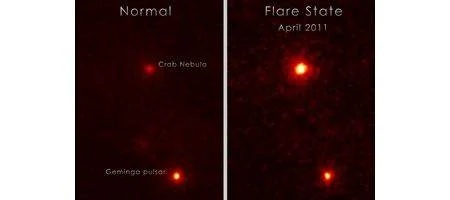Astronomers have observed a massive ‘superflare’ from the Crab Nebula – but are scratching their heads to try to explain it.

The flare, first detected by the Fermi Gamma-ray Space Telescope, was five times more powerful than any previously seen from the object, and lasted six days.
The nebula is the wreckage of an exploded star whose light first reached Earth in 1054. It is located 6,500 light-years away in the constellation Taurus and contains at its heart a superdense neutron star that spins 30 times a second. With each rotation, the star swings intense beams of radiation toward Earth, creating the pulsed emission characteristic of spinning neutron stars, or pulsars.
“The Crab Nebula hosts high-energy variability that we’re only now fully appreciating,” says Rolf Buehler of the Fermi Large Area Telescope (LAT) team.
Since 2009, Fermi and the Italian Space Agency’s AGILE satellite have detected several short-lived gamma-ray flares at energies greater than 100 million electron volts (eV).
But on April 12, they saw a flare that grew about 30 times more energetic than the nebula’s normal gamma-ray output and about five times more powerful than previous outbursts. On April 16, an even brighter flare erupted – but within a couple of days, the unusual activity completely faded out.
“These superflares are the most intense outbursts we’ve seen to date, and they are all extremely puzzling events,” says Alice Harding at NASA’s Goddard Space Flight Center.
“We think they are caused by sudden rearrangements of the magnetic field not far from the neutron star, but exactly where that’s happening remains a mystery.”
The Crab’s high-energy emissions are thought to be the result of physical processes that tap into the neutron star’s rapid spin. Theorists generally agree the flares must arise within about one-third of a light-year from the neutron star, but it’s so far been impossible to locate them more precisely.






